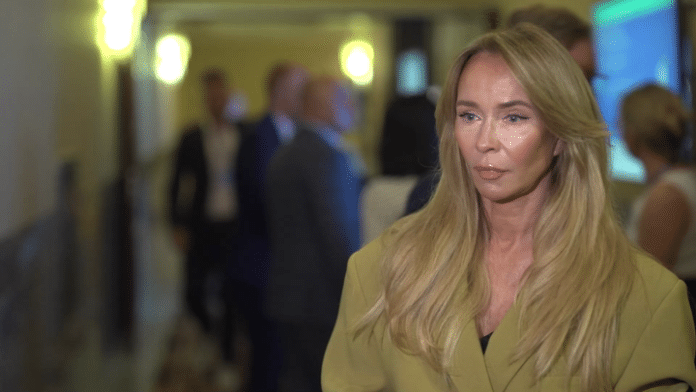“In the moment when clothing giants are producing several million pieces of one item, there is no chance for eco-friendly fashion and halting the trend of fast fashion,” believes Joanna Przetakiewicz-Rooyens. The manufacturing of vast quantities of cheap, low-quality clothing, as well as their washing and packing, involves immense water and energy consumption, whilst transportation leaves a substantial carbon footprint. The designer emphasizes that the clothing industry uses many types of materials and it’s hard to determine which ones are the best for the environment. Unfortunately, popular cotton is certainly not a good choice, partly because its harvesting and production require huge quantities of water and chemicals. Furthermore, it is transported from distant parts of the globe, which further increases CO2 emissions.
One of the discussion panels at the XXXII Economic Forum in Karpacz was titled “Is eco-friendly fashion available to everyone really possible?”. Participants in the debate discussed the issue of sustainable development in the fashion industry, its impact on the environment, and the availability of eco-friendly products for all consumers. Joanna Przetakiewicz-Rooyens, who took part in this discussion, has no doubts on this subject.
“Eco-friendly fashion available to everyone does not currently exist in full. It is an illusion because today we have clothing giants who flood the market with millions of pieces of one item,” says Joanna Przetakiewicz-Rooyens to Newseria Lifestyle news agency.
Fashion brands continually introduce new seasonal and even mid-season collections. At this point, the designer recalls a conversation with a British businessman.
“I once had an encounter that made me aware of the enormity of mass production. I met the owner of Topshop, Sir Philip Green, and we started talking about fashion. He asked me: ‘If you have a bestseller, how many pieces do you produce?’. I said: ‘Usually 100-200, if it’s something exceptional. And you?’. He replied: ‘3.5 to 5 million’. That made me realize the huge gap between boutique companies and giant clothing conglomerates. And in this situation, until these giants are sanctioned by new laws, we practically have no chance of winning against the trend of fast fashion,” she says.
Joanna Przetakiewicz-Rooyens notes that fashion and ecology absolutely do not go hand in hand. The fashion industry is the second most harmful sector for the environment. Clothing production consumes vast amounts of water and energy.
“Today there is not a single brand that is 100 percent eco-friendly. We are not aware of many things. For example, a cotton T-shirt requires 2,700 liters of water, which is what one person drinks in 2.5 years. The same T-shirt passes through the hands of an average of 150 people. Or we think that a pair of jeans is natural, organic, because it’s cotton, it’s a natural product, yet it turns out that jeans consume not 2,700 liters of water, but up to 11,000 liters, which is what one person drinks in 10 years,” she emphasizes.
Another issue is the transport of materials to factories and then of the finished clothes to stores. The textile industry therefore leaves a huge carbon footprint. Experts estimate that it is responsible for 2-3 billion tons of CO2 emissions annually, which constitutes 10 percent of global emissions.
“Companies often import fabrics from distant countries, emitting huge amounts of CO2 along the way. As a result, sometimes materials with high ecological certificates, but which have travelled thousands of kilometers, are no longer eco-friendly. It’s an illusion. We are often misled,” says Joanna Przetakiewicz-Rooyens.
The designer emphasizes that fabrics that are considered fully eco-friendly often are not. Therefore, at this time, it’s important to primarily choose fabrics that can at least be easily recycled.
“There are materials that are biodegradable, and that’s critical because it turns out that some types of polyester are much more eco-friendly than natural materials that have been obtained in an extremely non-ecological way. Again, I give the example of cotton. It’s very often produced by burning the plants along with the soil using chemicals. Is that eco-friendly? Certainly not,” she says.
To make clothing from raw cotton, it’s subjected to a series of processes during which up to about 8,000 different chemicals are used, including dyes containing heavy metals, chlorine-based bleachers, or formaldehyde. To be more eco-friendly, the fashion world should be seeking various ways to obtain and reuse once used resources.
“There are already materials obtained, for example, from mushrooms, apple peels, or pineapple, but these fabrics are still tremendously expensive because their production is experimental. There’s also the filling for down jackets, which is obtained from a certain type of flowers, but this is still such a highly limited production and practically unattainable today, especially for smaller producers, and non-profitable for the big ones,” explains Joanna Przetakiewicz-Rooyens.


















